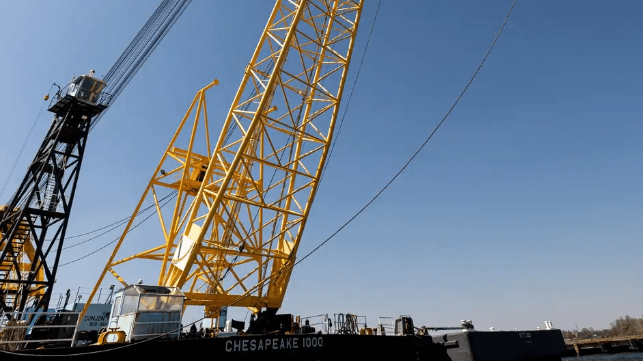The Biggest Crane Barge on the Baltimore Bridge Project Has a CIA Past

The largest crane barge on the U.S. East Coast has arrived in Baltimore to help remove the wreckage of the Francis Scott Key Bridge - and its past may come as a surprise.
The Chesapeake 1000 (ex name Sun 800) is a floating derrick with a capacity of 1,000 short tons. The venerable crane barge was built at Sun Shipbuilding in 1972, the same year as the famed CIA spy ship Glomar Explorer. This was not a coincidence: the barge was constructed by Sun Ship for use in its own yard, specifically for installing super-heavy components for the Glomar Explorer project.
The Glomar Explorer was one of the most remarkable covert projects of the Cold War era, with a cover story worthy of a spy novel. In the early 1970s, the CIA decided to build a ship that could retrieve a lost Soviet ballistic missile submarine from the seafloor off Hawaii. This unique ship would have a massive grab claw, which would scoop the submarine up and retrieve it (hopefully) in one piece.
In order to make sure that Moscow didn't learn of this plan, CIA leaders asked reclusive billionaire Howard Hughes to help out with a pretext for the operation. The future Glomar Explorer would be billed to the press as a Hughes-led expedition to prospect for deep-sea minerals in the Pacific - the first deep-sea mining project of its kind. Even Sun Shipbuilding, which won the contract for construction, did not appear to be in on the real mission.
When the real story leaked out in 1975, government sources told journalists that the mission was a partial success: Glomar Explorer arrived on site, deployed its claw, and retrieved the forward third of the submarine. The true mission objectives - the sub's code books and missiles - were lost when the other two-thirds of the sub slipped back down to the bottom.
The Sun 800 wasn't along for this deep-sea mission, but played an essential role in making it happen. The heavy derrick barge lifted the Glomar Explorer's 630-ton gimbal onto the ship during construction. (The vessel had a fully-gimbaled, heave-compensated derrick platform designed to damp out ship motion in the swells of the open Pacific.)
After the project, Sun Shipbuilding kept the Sun 800 on hand for other yard work, as well as marine construction and civil engineering projects. It was eventually sold on to another shipyard, then to salvor Donjon Marine, which operates it today as the Chesapeake 1000. It is expected to play a high-profile role in removing the wrecked bridge truss from the bow of the boxship Dali, which is currently pinned in place by the weight of the span.

that matters most
Get the latest maritime news delivered to your inbox daily.
For more on the infamous Glomar Explorer, be sure to read The Maritime Executive's two-part history of the project: https://maritime-executive.com/features/grand-finale-for-infamous-glomar-explorer
